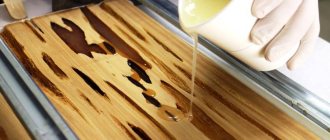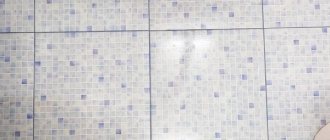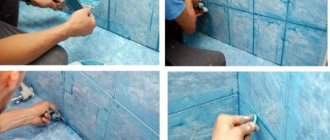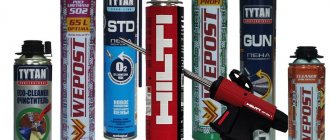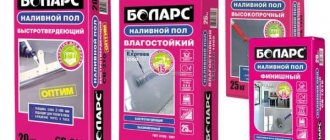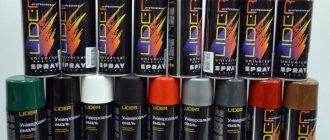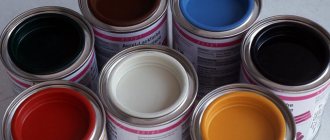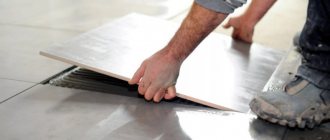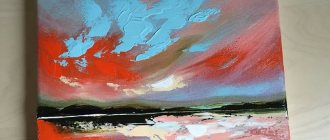Good health to all readers. Today's conversation is dedicated to paint. More specifically, I would like to talk about a problem that I encountered the other day. Having painted the floor in the hallway, I was extremely surprised that the surface remained sticky after a day of exposure. Although this is the maximum period indicated by the manufacturer, after which the layer must completely harden.
Source folksland.net
Be that as it may, you cannot walk on the floor. And I had to urgently look for ways to quickly dry the paint. And at the same time I figured out why such a phenomenon is even possible. And what needs to be done to avoid a similar problem in the future. Or at least quickly speed up the drying process.
The problem with paint taking a long time to dry
After applying the product, it takes some time for it to dry completely. Some coloring compounds (oil-based) require a very long time for this, and they have a strong smell and are harmful to the human body. The mirror surface created with varnish can be damaged by a simple touch if the substance is not completely dry.
In order to avoid unpleasant consequences and not to redo the work done, you need to study the properties of products from various manufacturers and take care to ensure suitable conditions for drying.
Preventing sticky floors
To get rid of this unpleasant side effect, you can rub the floor with a special mastic or wax. A thin glossy film will provide additional protection while improving decorative qualities.
Some experts recommend using a self-shining emulsion, which can be purchased at hardware stores, to protect the surface. The product is sprayed onto a clean surface once every 2-3 weeks, then rubbed with a dry cloth or sponge.
Another effective way is to cover the floor with high-quality varnish. Before starting work, level the surface with sandpaper, remove all roughness, and make it glossy. Then wash and degrease. If there are any flaws, smooth out with acrylic putty and, if necessary, tint and, after complete drying, varnish.
The varnish must be of high quality, increased durability and strength. There are compositions on sale that are specifically designed for parquets and floors - these are the only ones worth choosing. You can’t use ordinary universal substances; they don’t last long in a walk-through area and quickly wear out and get scratched.
It is necessary to wash freshly painted floors with oil-based paint before use. The procedure does not require a lot of time and physical effort or expensive means, but it significantly improves the quality of the coating and extends its service life.
Modern types of coloring compositions
There are many products on the paint and varnish market, the main characteristic of which is the drying time after application to the surface. Factors that influence drying time:
- humidity,
- air temperature,
- toner components,
- properties of the material that is being painted.
The most common types are alkyd, oil-based and quick-drying water-based. All types of paint coatings have different drying speeds and have both advantages and disadvantages.
Quick-drying, water-based
Such paints dry very quickly - in a few hours. They can be used for external and internal work. Compositions of this type can be used to paint any materials, including brick, concrete slabs, and gypsum structures. They are environmentally friendly and do not contain organic solvents. After painting, a vapor-proof film does not form on the walls and other surfaces, so they will breathe.
Popular varieties:
- water-emulsion and water-dispersion,
- latex,
- wallpaper,
- acrylic.
Alkyd compositions
Resins of natural origin are the basis of such products. Types:
- phenolic,
- urethane,
- pentaphthalic,
- glypthal.
They dry very quickly (up to 10 hours), but water-based dyes take less time to dry. The coating is applied to various surfaces without difficulty and is suitable for any type of work: decorative, finishing, artistic.
Alkyd enamels may contain solvents with a strong odor, so it is better not to use them for interior decoration in an apartment or residential building.
Oily
Paints of this type can be used for both facade and interior work. They are applied to metal, wood and other materials. A thick vapor-proof film is formed on the surface, so the painted room is flammable and toxic.
The oil tone takes a very long time to dry - up to several days. To speed up drying, special catalysts are added to the dye.
Cleaning products for freshly painted floors
Table vinegar is the most effective remedy for removing the stickiness of freshly painted floors.
Before washing the wood flooring after painting, you need to wait until the paint has completely dried. Then use table vinegar mixed with water for cleaning.
The instructions are very simple:
- Fill a clean bucket with almost hot water and add 1-2 tbsp. l. vinegar.
- Wash the floor with a clean, or better yet, new, soft cloth, using the prepared solution.
- Change the acidic solution in the bucket and repeat the procedure.
Then, for another 7 days in a row, wipe the floors with a damp cloth soaked in a mixture of water and vinegar to remove the oil that will continue to bleed from the inner layers of paint for some time.
Use of catalysts
Such products are called driers. They are sold in all construction and hardware stores in the repair goods departments. These substances accelerate the polymerization process, that is, they reduce the drying time of the wall or floor.
The drier is poured directly into the paint, enamel, varnish or other tinting agent. The instructions for use indicate the volume of catalyst that should be added to 1 liter of dye. It is important not to exceed the indicated dosages, since the solution may curdle during application.
Drying agent significantly speeds up drying time. For example, an oil-based foundation can dry out within a day at room temperature.
Special Additives
Various catalysts are added to some types of paint. They are also called driers. They can significantly accelerate the polymerization of the base composition.
Dryers can consist of various salts:
- manganese;
- cobalt;
- calcium;
- lead;
- barium;
- zirconium.
The best substances are those based on salts of carboxylic acids. It is the latter that act as a lifesaver when the acute question arises of how to quickly dry oil paint. And the addition of such additives allows you to expect a successful result within a day.
Source kraskaok.ru
Dryers can be mixed and used for different types of paint. They are added before stirring, but the proportions must be strictly observed. Otherwise, there is a danger that the paint may curl.
Correct application guarantees quick drying
When carrying out repair work, it is important to remember the factors that affect the drying time of paint compositions. If you apply the foundation correctly, it will dry quickly. Basic Rules:
- It is better to paint a wall or other surface in several stages - 2-3 thin layers will dry much faster than 1 thick one,
- oil solutions are applied with a roller or brush, but it is better to go with the first option, since in this case the substance will be more evenly distributed throughout the material,
- External work should be carried out in warm, dry weather,
- the use of a special spray gun reduces drying time,
- It is advisable to pre-heat the wall, and the tone will dry in a matter of hours.
Folk remedies for washing
Freshly painted wooden floors are washed for the first time with water with the addition of regular homemade kvass. The solution is prepared as follows: add 1 liter of kvass to a bucket of hot water. The more sour it is, the better. The floor is washed with this mixture several times, every day for a week. According to popular opinion, the first treatment with kvass is preferable; the surface is more shiny and lasts longer.
Washing floors with acidic compounds is the final stage of preparation for use. But regular care must be carried out constantly.
What to do if the paint doesn't dry?
Sometimes it happens that the coating is applied correctly, the rules for working with the paint are followed, but the wall or other surface does not dry. In this case, it is necessary to create suitable conditions that will help rapid drying:
- ensure constant air circulation in the room, it is advisable to create a strong draft: open the windows and swing open the doors,
- turn on the fan to artificially move air masses,
- remove all sources of moisture in the room,
- install additional heat sources in the room if the temperature is too low.
Is it possible to wash floors with vinegar after painting - what are the dangers of old methods?
It is possible, even necessary, to wash floors with vinegar after painting, but it is important to do it correctly: follow the proportions exactly and do not wash too early, until the paint has dried. Read on to learn how to wash the floor without damaging the fresh coating and why you should use vinegar.
Preparing the vinegar solution correctly
Household vinegar is universal: it not only destroys odors and has disinfectant properties, but also removes greasy stains. Quickly and efficiently copes with even minor dirt and dust that appears on a freshly painted surface, especially after drying. Housewives love this method of cleaning the floor for its effect of enhancing color saturation.
The first thing you need to do before washing is to properly prepare the vinegar solution. The procedure is important, since too hot water or a high concentration of vinegar will only aggravate the matter and cause unsightly stains.
A vinegar solution for cleaning floors after painting is prepared as follows:
- We take a standard plastic or zinc bucket with a volume of 10 liters.
- We collect a full bucket of hot water. The most important thing when cleaning the floor is to choose the right water temperature. It should not be boiling water, but also not just warm liquid. A suitable temperature is one at which you can hold your hand in the water, but not for long - up to 5-7 seconds.
- Add 2 tablespoons of simple vinegar to the water. It is also called household or home. Concentrated acetic acid, even if it is found in the house, cannot be used.
- Mix thoroughly for 15–20 seconds.
- Let's start cleaning the floor.
By exceeding the concentration of vinegar in the solution, you can first cause the enamel to lose color and subsequently peel it off. Vinegar, even household vinegar, is a very aggressive substance and should be used extremely carefully.
Ammonia can be a high-quality and inexpensive replacement for vinegar. But the proportions are different - 1 tablespoon per 6-8 liters of water is enough. Remember that a large amount of the drug in the solution will have the opposite effect.
How to wash the floor with vinegar without consequences?
The vinegar solution is ready: the water is at the required temperature, and the amount of vinegar does not exceed two tablespoons. You can start cleaning the floor.
We recommend: Rules for cleaning gold-plated silver at home
The sequence of proper floor cleaning with vinegar solution:
- Soak a soft cloth in the solution and wring it out well. Remember: too wet rags will cause new stains or permanent fading of the enamel. Therefore, the rag for washing the floor should be damp, but not wet.
- After carefully washing no more than 3 m2 of floor, you need to change the solution to fresh one. And so on until the entire freshly painted surface is washed.
- Under no circumstances should you re-rinse an already clean surface. It's better to do this in a few days. Rubbing the surface is also not recommended, because vinegar, even in low concentration, remains too active a substance that can break down some paints and varnishes.
- After the area has been treated with a vinegar solution, you should carefully wipe the floor with a cloth soaked in clean water, without adding any detergents.
It is better to use soft rags for cleaning floors and replace them after several procedures. Dirty rags with small or large debris will be the first cause of scuffs and scratches on a newly painted floor.
When can you start cleaning the floor?
The floor is painted and shiny with fresh enamel, floor paint or varnish. The question arises: when can you start washing? Answer: not immediately and not even after 2-3 days.
- First, the enamel should be given time to dry thoroughly.
- Secondly, the coloring composition must be absorbed into the wood. This process is lengthy - even with proper air circulation and constant room temperature, it takes at least two weeks.
Some home craftsmen make a mistake: after a few days they try the painted floor by touch and, if the enamel or paint does not stick to the hand, then immediately start washing it. It is not right. The topmost layer dries very quickly, within a day it feels like you can walk on the floor. But the lower layers will take time, sometimes a lot of time. Therefore, remember: you can wash the painted floor no earlier than after 1.5–2 weeks.
What should you not do?
Never try to get rid of stains on a freshly painted floor using simple laundry soap and hot water. This is a serious mistake that will lead to new problems:
- even more divorces;
- fading of enamel;
- possible peeling of the coating.
Temperature effect
The paint dries at the moment when the solvent completely evaporates from it. This process can happen much faster if you raise the temperature and lower the humidity level in the room. This can be easily achieved using the following devices:
- construction hair dryer,
- infrared heater.
The use of such technology requires compliance with certain rules:
- Sufficient distance from the painted surface to avoid the formation of cracks.
- A gradual increase in temperature, otherwise the applied paint layer may be irrevocably damaged.
Useful tips
Recommendations from experts that should be followed to quickly dry the tinting substance after application:
- It is necessary to add a drier to oil paint. It will speed up the drying process even when reapplying the composition.
- During renovations in a residential area, it is better to replace paint coatings with alkyd ones.
- Before painting, you need to warm up the room, since the tone applied in a cold room will quickly thicken in low temperatures, dry slowly and be difficult to distribute with a brush or roller.
- The thinner the paint layer, the sooner it will dry. If after this you can see translucent areas on the material, all painting procedures are repeated every other day.
- To avoid enamel oxidation, it is necessary to ensure constant air circulation in the room; it is better to artificially create a draft.
- The most favorable conditions are low humidity and high air temperature.
- Modern construction hair dryers have a separate function for drying paint. When using the device, it is important to avoid sudden temperature changes and bring it too close to the painted surface, since the applied layer may crack.
- Small parts coated with tone can be placed close to heating radiators or dried in the oven by selecting a special mode at a temperature of no more than 60 °C.
- An infrared heater will help dry a wall, ceiling or floor due to its ability to penetrate under the dye layer and heat it from the inside. The paint composition, spreading, is evenly distributed over the plane, so it dries in a matter of hours.
The problem of paint taking a long time to dry remains relevant. Quick-drying water-based solutions may not always be at hand, so you should follow certain rules to ensure that oil and other coatings dry quickly. The use of special catalysts and devices such as a hair dryer or infrared heater will significantly reduce the drying time. However, even in their absence, you can achieve the desired result by creating suitable conditions in the room.
Compliance with technology
Let's look at how you can quickly dry oil paint when working on your own. And for this we will listen to the professionals. And they say that the drying time of the surface directly depends on the thickness of the applied layer.
Source sostav.ru
Factors affecting the quality of the coating:
- It is impossible to apply the same pressure on the hand all the time. Therefore, much more paint is consumed than it should be, and the thickness of the application is significantly overestimated.
- The roller allows you to apply a thinner and more uniform layer. Therefore, the drying time at the surface at any point will be the same.
- A thinner layer can only be achieved when using a spray gun or an aerosol can.
By applying these tips and combining them with techniques to speed up drying, you can get great results. In some cases, the surface will be hard after 5 hours. But even the most capricious materials will not take more than one day to repair.
Source gidpokraske.ru
